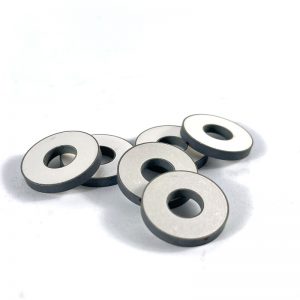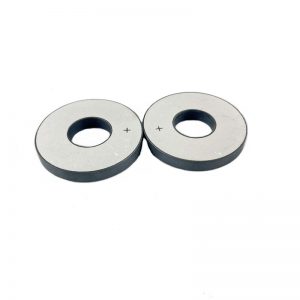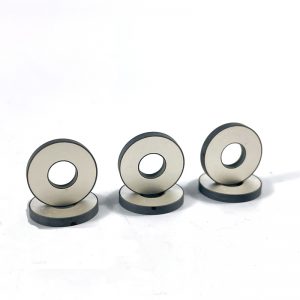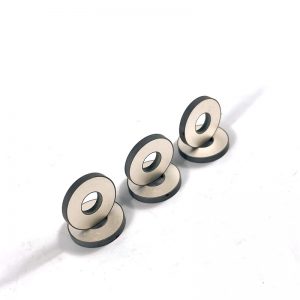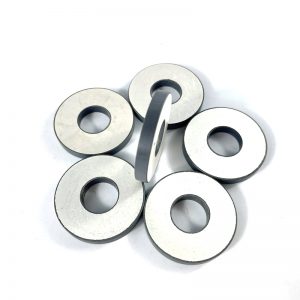 Commonly used piezoelectric ceramics include barium titanate system, lead zirconate titanate binary system, and ternary systems composed of Pb (Mn1/3Nb2/3) O3 and Pb (Co1/3Nb2/3) O3 by adding a third type of ABO3 (A represents divalent metal ions, B represents tetravalent metal ions, or the sum of several ions is positive tetravalent) to the binary system. If a fourth or more compound is added to the ternary system, a quaternary or multivariate piezoelectric ceramic can be formed. In addition, there is also a type of niobate based piezoelectric ceramics, such as sodium potassium niobate (Na0.5 · K0.5 · NbO3) and barium strontium niobate (Bax · Sr1-x · Nb2O5), which do not contain toxic lead and are beneficial for environmental protection.
Commonly used piezoelectric ceramics include barium titanate system, lead zirconate titanate binary system, and ternary systems composed of Pb (Mn1/3Nb2/3) O3 and Pb (Co1/3Nb2/3) O3 by adding a third type of ABO3 (A represents divalent metal ions, B represents tetravalent metal ions, or the sum of several ions is positive tetravalent) to the binary system. If a fourth or more compound is added to the ternary system, a quaternary or multivariate piezoelectric ceramic can be formed. In addition, there is also a type of niobate based piezoelectric ceramics, such as sodium potassium niobate (Na0.5 · K0.5 · NbO3) and barium strontium niobate (Bax · Sr1-x · Nb2O5), which do not contain toxic lead and are beneficial for environmental protection.
| spec | Dimension (mm) |
Radial frequency (KHz로) |
Capacitance (pf) |
Dielectric dissipation factor tanδ(%) |
Electromechanical coupling coefficient (Kr) |
Impedance Zr(Ω) |
Thickness frequency (KHz로) |
| PU-PC25103 | Φ25×Φ10×3 | 66.4 | 1240±12.5% | ≤0.3 | ≥0.46 | ≤15 | 683±5% |
| PU-PC225104 | Φ25×Φ10×4 | 66.4 | 930±12.5% | ≤0.3 | ≥0.46 | ≤15 | 512±5% |
| PU-PC40155 | Φ40×Φ12×5 | 45.9 | 2070±12.5% | ≤0.3 | ≥0.46 | ≤15 | 410±5% |
| PU-PC40155 | Φ40×Φ15×5 | 42.2 | 1960±12.5% | ≤0.3 | ≥0.46 | ≤15 | 323±5% |
| PU-PC40176 | Φ40×Φ17×6 | 40.5 | 1555±12.5% | ≤0.3 | ≥0.46 | ≤15 | 341±5% |
| PU-PC40205 | Φ40×Φ20×5 | 37.9 | 1700±12.5% | ≤0.3 | ≥0.47 | ≤15 | 410±5% |
| PU-PC50206 | Φ50×Φ20×6 | 33.2 | 2490±12.5% | ≤0.3 | ≥0.46 | ≤15 | 341±5% |
| PU-PC501765 | Φ50×Φ17×6.5 | 34.8 | 2430±12.5% | ≤0.3 | ≥0.46 | ≤15 | 315±5% |
| PU-PC50236 | Φ50×Φ23×6 | 31.2 | 2340±12.5% | ≤0.3 | ≥0.47 | ≤15 | 341±5% |
| PU-PC50276 | Φ50×Φ27×6 | 29.3 | 2100±12.5% | ≤0.3 | ≥0.47 | ≤15 | 341±5% |
| PU-PC603010 | Φ60×Φ30×10 | 25.3 | 1922±12.5% | ≤0.3 | ≥0.47 | ≤18 | 205±5% |
 초음파 변환기,초음파 발생기,초음파 세척기 - SKSONIC
초음파 변환기,초음파 발생기,초음파 세척기 - SKSONIC
